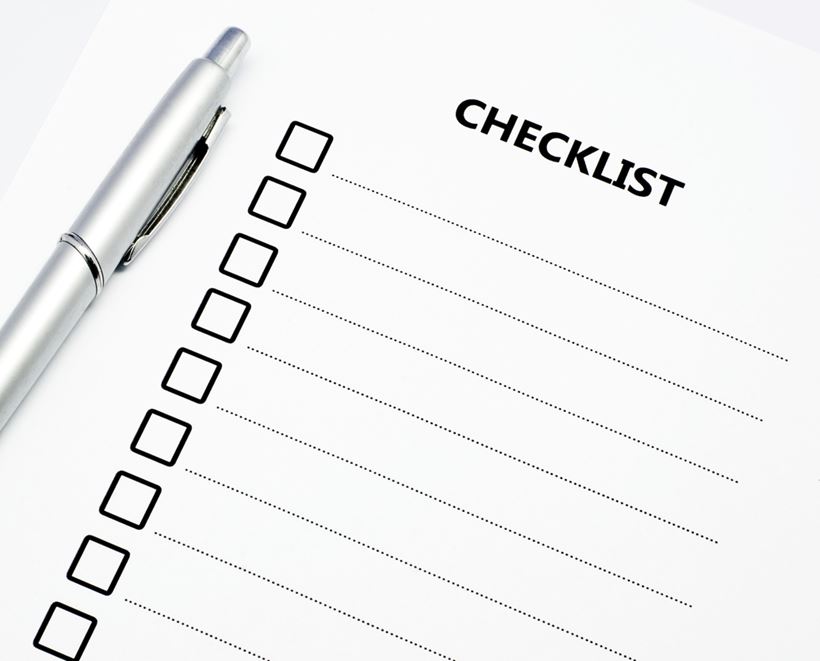Moving is hectic, and it's easy to forget certain belongings and tasks in the whirlwind of activity. Depending on how far the new location is from your current home, returning to pick up things you left behind might not be an option. To make relocating easier, create a moving checklist that starts at least four weeks from the move-out date. Here are a few things to keep in mind each week as the moving date approaches:
"Drive things to a donation center one month before your move."
4 weeks before the move
A month before the move-out date is when you should start marking items off of your moving checklist. You might think this is a little early, but it'll make everything run a lot more smoothly because you won't be rushing to get things done at the end of the month.
This far out, your list will only contain a few tasks. For instance, you should arrange to have your insurance transferred to your new home, and, if you have kids, you should also start the paperwork associated with transferring them to a new school district. With these out of the way, you can begin walking through each room of your house, including the garage. Think about whether there is anything you and your family no longer use. Now is the time to drive things to a donation center or plan a yard sale. Either way, collect the items you don't want into boxes or garbage bags and keep them separate from all of your other belongings. This way, they won't end up at your new place after the move.
This is also the perfect time to look for a moving company. Take a day or two to research so you choose a reliable service. Ask friends and family for suggestions, and read online reviews about movers you're interested in using. If it's busy season, it's better to reserve services now so you don't have to scramble to find an available agent later.
3 weeks before the move
With three weeks before the move, start trying to use the perishable food in your kitchen. Then, you won't have to deal with items that will spoil or rot, and instead, you can simply pack up canned goods and other non-perishable items. If you need to buy things like milk during the next couple of weeks, make sure you choose smaller sizes, like 1/2 gallon.
You can also take this time to notify the post office about your change of address. You'll need to fill out a form so your mail will get sent to the correct location after you've moved. It's also a good idea to schedule utility disconnection. If you do it now, you won't have to pay for services longer than necessary.
At three weeks out, you can start to do a little packing. Gather boxes, markers and bubble wrap to use on your belongings. Store items you rarely use first so you don't have to worry about digging through boxes in the next few weeks. You should also be noting what's inside each container as you put items inside. This way, if you do need to find something, it should be relatively easy to locate.

2 weeks before the move
A couple of weeks before you move out of your old house, make travel reservations. A long-distance move will require at least one night in a hotel, so make sure you have lodging sorted out in advance.
After your hotel is booked, start walking through the house and making a pile of things that do not belong to you. For instance, maybe you have some books checked out from the library, or perhaps you borrowed a yard tool from a neighbor. Gathering these items now will make it a lot easier to return them to their rightful owners.
In addition, create an inventory checklist of all your belongings, from the sofa and lawn mower to the box of kitchen utensils. Making a list will allow you to check that everything arrives at your new home safely. With your inventory record in hand, you can simply mark off what's in your new place. This will help you notice if anything is missing right away instead of realizing you don't have your holiday boxes a month or two after you've settled into your house.
With the inventory checklist out of the way, the only thing left for your two-week marker is to arrange for utilities to be connected in your new home. This way, you won't have to worry about not having power when you move in.
"Create your own checklist with the Atlas Van Lines personalized checklist calendar."
1 week before the move
The last week leading up to your move can become very busy. Now is the time to start seriously boxing up your belongings and filling up your suitcases. Make sure you put items you might need during the move in an easily accessible location. Set aside items you plan to take with you in the car. For example, you might want to have some snacks, clothes, toiletries and games in a special container along with other items you may be using right away.
Once this is done, make arrangements to have a new bank account set up if your current bank will not be near your new location. This way, you'll be able to manage your money easily once you've moved in. However, you should wait to close your other accounts until after you've finished your relocation.
On the day of your move, pack up the last few items you have and remind friends of your new address. For more moving checklist ideas, create your own day-by-day list with the Atlas Van Lines personalized checklist calendar.

